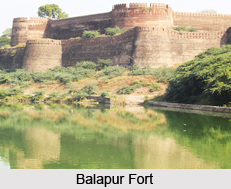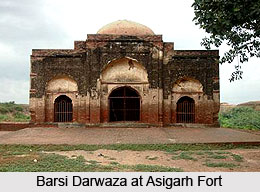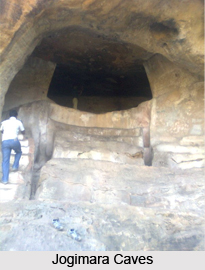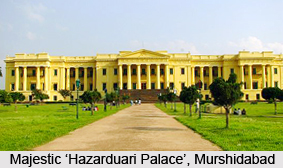 Hazarduari Palace was previously referred to as `Bara Kothi` and is present in the region of `Kila Nizamat` in Murshidabad city, West Bengal. It had been constructed during the regime of Nawab Nazim Humayun Jah who reigned over Odisha, Bihar and Bengal about 1824 till 1838. An architect known as Duncan Macleod is credited for this renowned architectural grandeur in the eastern Indian state of West Bengal. During 9th August, 1829, the foundation stone of Hazarduari Palace had been laid and it is believed that the construction work had commenced on that very day. During that point of time, William Cavendish was the Governor-General of Bengal. Currently, this palace is the most prominent historical structure in Murshidabad and the Archaeological Survey of India or ASI has been entrusted the duty of supervising the palace since 1985. Finally in the year 1837, the construction of the palace concluded.
Hazarduari Palace was previously referred to as `Bara Kothi` and is present in the region of `Kila Nizamat` in Murshidabad city, West Bengal. It had been constructed during the regime of Nawab Nazim Humayun Jah who reigned over Odisha, Bihar and Bengal about 1824 till 1838. An architect known as Duncan Macleod is credited for this renowned architectural grandeur in the eastern Indian state of West Bengal. During 9th August, 1829, the foundation stone of Hazarduari Palace had been laid and it is believed that the construction work had commenced on that very day. During that point of time, William Cavendish was the Governor-General of Bengal. Currently, this palace is the most prominent historical structure in Murshidabad and the Archaeological Survey of India or ASI has been entrusted the duty of supervising the palace since 1985. Finally in the year 1837, the construction of the palace concluded.
It is said that the foundation stone was quite high which caused troubles for the Nawab who employed the aide of a ladder to descend down the structure. Historical sources have asserted that the wife of Nawab Nazim Humayun Jah had fainted from sheer suffocation on account of the large congregation of people who surrounded her while she was standing near the foundations of Hazarduari Palace. After this unfortunate incident, the foundations were laid more appropriately and the foundation stone was established more soundly.
Hazarduari Palace has been named so due to the existence of a thousand doors and therefore it implies, `a palace with a thousand doors`, while `Hazar` means `thousand` and `Duari` stands for `the one with doors`. In the olden times, this great palace was known as Bara Kothi due to its gigantic structure which possesses 1000 doors of which 900 are false. However, these numerous doors had been erected with an aim to catch hold of predators if they made an attempt to escape after a theft or burglary. The palace had been so designed that the guards of the Nawab would be capable of nabbing them instantly, while they would be severely confused between the false and real doors.
Kila Nizamat
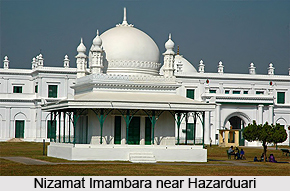 Nizamat Fort or `Kila Nizamat` which is also known as `Nizamat Kila` was the very area where the old fort of Murshidabad was located. Kila Nizamat is situated on the current site of Hazarduari Palace which is on the banks of Bhagirathi River. However, this fort was destroyed in order to create the beautiful Hazarduari Palace. Presently, Kila Nizamat is known to be the spot where the Hazarduari Palace is based, along with Madina Mosque, Nizamat Imambara, Bacchawali Tope, Wasif Manzil, Chawk Masjid, two Zurud mosques one of which is located on the eastern side of the palace and another between the southern gate of the palace and the Wasif Manzil, the Shia Complex and also the Nawab Bahadur`s Institution or Nizamat College which surrounds it.
Nizamat Fort or `Kila Nizamat` which is also known as `Nizamat Kila` was the very area where the old fort of Murshidabad was located. Kila Nizamat is situated on the current site of Hazarduari Palace which is on the banks of Bhagirathi River. However, this fort was destroyed in order to create the beautiful Hazarduari Palace. Presently, Kila Nizamat is known to be the spot where the Hazarduari Palace is based, along with Madina Mosque, Nizamat Imambara, Bacchawali Tope, Wasif Manzil, Chawk Masjid, two Zurud mosques one of which is located on the eastern side of the palace and another between the southern gate of the palace and the Wasif Manzil, the Shia Complex and also the Nawab Bahadur`s Institution or Nizamat College which surrounds it.
Architecture of Hazarduari Palace
Hazarduari Palace is existent on the eastern banks of Bhagirathi River which flows beside this Indian river. The palace is located at a gap of about 40 feet away from the river banks of Bhagirathi River. Deep foundations characterise the palace, which are used to defend this palace. This rectangular-shaped palace measures 61 metres in width and 130 metres in length and is an excellent instance of Indo-European style of architecture. A grand flight of staircase is present on the anterior portion of the palace which faces towards the north, and this particular series of stairs are believed to be the largest one in the entire world.
The 37 steps of stone are utilized as stairs, and the lowest stair measures nearly 108 feet in length and it leads to the upper portico of the Hazarduari Palace. Two statues composed of seated masonry Victorian lions exist near the stairs, which are equipped with stone slabs fixed to the wall behind them. 114 rooms and 1000 doors are some of the features of the palace. Seven large gates serve as significant entrances to the palace which is referred to by certain names like `Dakshin Darwaza` or southern gate, `Chawk`, `Imambara` and so on. Musicians` galleries or `Naubat Khanas` are present near the main gates and are very large.
Official or royal meetings used to be organised in Hazarduari Palace which was also utilized as a royal residence by high ranking British officers. The palace was frequently used by Nawabs for official works. Today, Hazarduari Palace has metamorphosed into a famous museum which contains furniture, antiques, expensive paintings and various artefacts employed by the Nawabs, including the royal chandeliers. The original dwelling palace of the Nawabs was constructed at a different place but it is believed to possess an identical name since during those times the Indian Nawabs were mere puppets whose acts were influenced by the Dual government of the British Raj in the country.
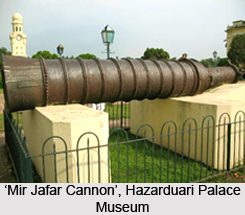 Other Buildings in Hazarduari Palace grounds
Other Buildings in Hazarduari Palace grounds
Nizamat Imambara is manufactured out of wood and it was created by Nawab Siraj-Ud-Daulah which had caught fire in the year 1846. Therefore, the current structure had been re-established during 1848 by Nawab Nazim Feradun Jah who ruled Bengal, Odisha and also Bihar. The Imambara is considered the largest one in the whole nation and a large sum of money is believed to have been splurged to construct it. Located near Hazarduari Palace is also the Madina Mosque which is open during Muharram and closed throughout the entire year. A cannon is placed on the altar of the Bacchawali Tope which is present in the grounds of Kila Nizamat and the cannon lies covered in an iron gate. Legend states that whenever this cannon used to be fired it emitted such a loud noise that it compelled pregnant ladies to deliver babies almost at that very same time.
Museum of Hazarduari Palace
Some of the most renowned collections of Hazarduari Palace are the chandeliers and the great mirror which were used by the then Nawabs. The Museum of Hazarduari Palace is said to be the largest and grandest site of museum by the ASI and it possesses 20 galleries which had been displayed and consisted of 4742 antiquities, from which 1034 has been exhibited for the general public. Stucco and porcelain statues, marble statues, rare books, ancient maps and manuscripts, `farmans`, metal artefacts, oil paintings accomplished by French, Italian and Dutch painters, old palanquins of the 18th and 19th centuries, a bamboo belonging to Assam, land revenue records, etc are amongst the innumerable well-known objects which are displayed at the Palace Museum. Crystal chandelier and furniture utilized by Nawab lies inside the Durbar Hall of the palace. This grand chandelier is said to be second biggest chandelier in the entire world, just after the one inside Buckingham Palace and this was offered to the Nawab by Queen Victoria.
Two pairs of mirrors are present, which have been kept at 90 degrees in which though others can view somebody`s face, he himself would be unable to do so. Nawab used the mirrors to prevent the predators from causing him harm. The swords of Nawab Siraj-ud-Daulah and Alivardi Khan, a dagger which was used by Muhammad-i-Beg to kill Siraj-ud-Daulah, a Dutch cannon or the `Mir Jafar Cannon` which was gifted to Alivardi Khan by the British Government during 1745, an in ivory palanquin which was utilized by Aurangzeb`s daughter Zebunissa, an ivory `Tanjam` belonging to the Nawab as well as his sons, a magnificent silver `kamal howdah` are only a few of the several exquisite historical objects which are displayed in the Museum. At a time when electricity was not available, 1001 candles used to light up the enormous chandelier which is currently lighted up by 96 bulbs. Candle stands, a royal silver throne and a Durbari `Hookah` which once belonged to the British Raj in India are also a part of the collections of the museum. A `Nizamat Library` which possesses numerable books which amount to 12, 000 books, of which books in Persian, Urdu and English language are existent is also quite popular.


